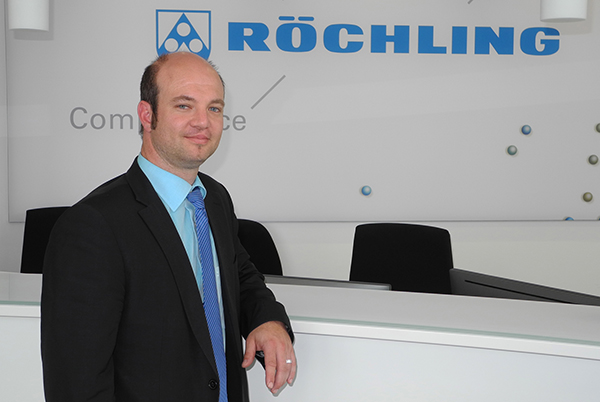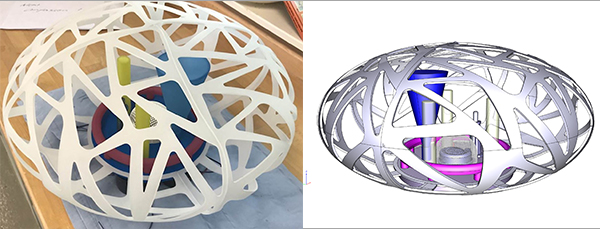
|
Röchling Automotive: 3D PDFs improve digital information flowsBy Timo Trautmann Digital information flows provide the basis for the fast and reliable handling of development projects. Digitalizing them, however, is no easy task for automotive suppliers with heterogeneous IT system landscapes. Röchling Automotive uses interactive 3D PDF product data sheets as the common denominator for providing users in downstream departments with digital CAD and PLM data at an early stage. With a workforce of over 5,500 and sales of almost one billion euros, Röchling Automotive is the largest division in the Röchling Group, which specializes in the processing of engineering-grade plastics for customers in the automotive, capital goods and medical and pharmaceutical technology industries. The Automotive division of the almost 200-year-old, family-owned company supplies OEMs and tier 1 suppliers with system solutions and components such as, for example, active aerodynamic systems in the aerodynamics sector, A/C air ducts and exhaust aftertreatment systems in the powertrain sector and lightweight structures and battery systems in the new mobility sector. The automotive supplier aims to maintain a global presence and close proximity to its customers with its 44 locations worldwide. At Röchling Automotive, the use of digital technologies is an important tool for optimizing its own value chain, from conceptualization to the development and manufacture of the products through to the end of their lives as spare parts, and automating cross-company processes that interface to the automobile manufacturers. The aim is use PROSTEP's 3D PDF technology to enable users at the various locations to share information more easily and collaborate more efficiently on globally distributed development projects, as Andreas Lupfer, Team Leader PLM / SAP Application Support, says: “When it comes to projects, Röchling Automotive relies on regional customer proximity, but products are increasingly being developed in global teams in order to exploit and expand existing know-how.” 
Development work is carried out in Worms (Germany), Leifers (Italy) and at two other locations in the USA and China. The 213 design engineers worldwide work predominantly with the CAD system CATIA but also with Siemens NX and PTC Creo. Their heterogeneous CAD environment is primarily the result of customer requirements, as Lupfer explains: "We receive clear specifications from the OEMs as to what data we have to deliver and how. That is why we always use the customer's system configuration, even if we frequently exchange the data using the neutral STEP format". PROSTEP's data exchange solution OpenDXM – used in conjunction with the Enterprise Connector from CENIT, which controls the import to and export from SAP – ensures that the data is sent securely. Heterogeneous CAD system landscape Röchling Automotive currently maintains 38 different CAD system environments with different releases, start models, libraries, etc., which entails considerable administrative overhead. Releases 19 to 26 of CATIA alone are currently in use, with more to be added soon. The ERP and PLM environment is more homogeneous with SAP as the central data backbone and the CAD desktop as the uniform engineering front-end for access to the various CAD systems, whose data is stored on decentralized content servers at the respective locations for performance reasons. The CAD desktop is currently being replaced by the SAP ECTR software, says Lupfer. His team is responsible for the central SAP installation with regard to CAD components and interfaces and also deals with the global concept for data exchange. While product data sheets are primarily intended for communication within the company, STEP is the main format for exchanging data with OEMs and external partners. STEP data is however also required internally for downstream processes such as prototype construction and toolmaking if users are unable to use the native data. When it came to converting the data, the company originally used the Visual Enterprise Generator from SAP, which can convert different CAD formats into STEP data. However, information was repeatedly lost or incorrectly interpreted, something that sometimes did not become apparent until a tool was completed and which then proved costly. Röchling Automotive replaced the previous generator with the conversion solution from SEAL Systems with the aim of improving the quality of the STEP data and reducing the amount of time and effort required for data conversion. A separate conversion server was set up at each development site for each CAD system in use to minimize data transfer. There are a total of nine such servers, which can be used remotely from other locations. As part of the project, PROSTEP's PDF Generator 3D was also installed at all four locations to place the generation of product data sheets on a new footing. SEAL Systems brought PROSTEP AG on board as a partner for this subproject. Simple product data sheets had been used in the past as an important means of communication between design, purchasing, project management, quality assurance, prototype construction and other departments that do not have CAD workstations but want to view the design data early on. However, the data sheets usually only contained views and models of individual parts and not all the relevant information, says Lupfer: "For example, our existing solution didn't allow us to map the BOMs in their entirety nor did they allows us to navigate the product structure. If you wanted to view a different component, you had to enter the material number in SAP and load the corresponding data sheet." 
All the information in a single 3D PDF The 3D PDF solution that PROSTEP implemented together with SEAL Systems makes it possible to automatically merge all the data and documents required for downstream processes in a compact, multi-page 3D PDF container for the first time. In addition to the CAD models, this includes classification information for the individual components and the BOMs from SAP PLM in particular. Because the new product data sheet contains all the relevant assembly information, it can be sent by e-mail and if necessary also be used without SAP access. One of the considerable advantages of the solution is that the information is linked interactively, as Lupfer points out: "If users click on an item in the BOM, the corresponding component is highlighted in color. If they click on a component, they see the corresponding BOM item along with the classification data. They can show and hide components, making it much easier to filter out the information they require for their work." The possibilities for interaction are not limited to navigation between BOMs, classification information and 3D models. In what is referred to as "Move Mode", users can remove the links between parts manually to create exploded views of assemblies and annotate individual components. This means that the product data sheets also support processes such as customer design reviews or the coordination of engineering changes, for which PowerPoint documents with views of the components to be changed are still often generated today. Each product data sheet contains a breakdown of the BOM structure with a list of all the components, which can be easily identified with the aid of thumbnails in JPEG format. PDF Generator 3D generates these thumbnails during the conversion of the components into 3D PDFs. They have a significantly better quality than the thumbnails originally used in SAP, which were derived directly from the CAD models. PROSTEP has therefore set up a workflow that automatically replaces the old thumbnails in SAP as part of the process for converting existing product data sheets. A total of approximately 21,000 product data sheets were subsequently converted in order to improve their quality. As mentioned earlier, the old data sheets did not have the same level of detail and were based on STEP data that had not always been converted correctly and in its entirety. 
Automatic generation of 3D PDFs PDF Generator 3D automatically generates new product data sheets as soon as the designed components have reached a specific level of maturity, which is usually when the status changes to "for review". The automated process is based on STEP conversion but is independent of it. Once ECTR implementation has been completed, Röchling Automotive will add the option of manually triggering generation on demand, so that the company's own tool shop can be informed of upcoming projects at an even earlier stage for example. The 3D PDFs are stamped with a digital watermark to avoid errors resulting from the use of documents that have not yet been approved. It provides information about their status and remains intact even when the 3D PDFs are printed, copied or sent via e-mail. If the status changes, the product data sheet does not have to be generated again, only the stamp has to be updated or, following approval, removed completely. The digital stamp function is part of the conversion solution from SEAL Systems but is triggered via an interface directly from within PROSTEP's 3D PDF solution. Lupfer praises the collaboration between the two partners during implementation of the solution. While native CAD data and neutral formats were previously stored in different data repositories, the PLM system now manages the product data sheets together with CAD and STEP files as different document types under the same document number. Access is regulated by a differentiated, role-based rights concept that was implemented as part of the project, as Lupfer says: "We've determined which user groups and departments need which information at which point in time, and the status network has been developed in line with the roles so that certain employees can access the product data sheets earlier than others." The design engineers however can always view the native CAD data. Basis for digital business processes
Approximately 600 employees in different departments around the world currently use the product data sheets as their initial source of information. One immediate beneficial effect as far as the IT department is concerned is the higher quality of the 3D data provided. This is reflected, among other things, by the fact that IT has fewer error messages to process. From the user's point of view, the most important advantage is earlier access to all the relevant product data, which helps to avoid errors in downstream processes and facilitates collaboration especially in global projects, as Dr. Gernot Kramer, Head of Development at Automotive Röchling in Italy, explains.
Implementation of PROSTEP's 3D PDF solution means that the company has now created a basis for digitalizing its business processes, says Lupfer. "Now it's time to think about how the technology can be used to further optimize the processes. We are, for example, thinking about also making the product data available in HTML5 format in the web so that users can access it more easily on their mobile devices." Röchling Automotive also wants to automate the conversion of lightweight JT data with PROSTEP's help so that they can exploit the possibilities offered by 3D views in SAP ECTR. 
|
|
| © PROSTEP AG | ALL RIGHTS RESERVED | IMPRESSUM | DATENSCHUTZERKLÄRUNG | HIER KÖNNEN SIE DEN NEWSLETTER ABBESTELLEN. |

